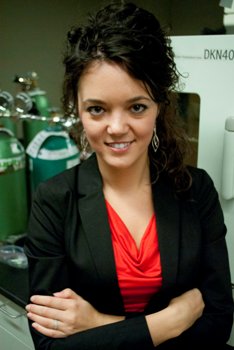Researchers from multiple institutions have joined together in an endeavor to develop better multicomponent catalytic processes and materials for producing more effective and cost-effective materials such as polymers and chemicals. The National Science Foundation has awarded nearly $1.5 million for this project under the Designing Materials to Revolutionize and Engineer our Future initiative.
 Eranda Nikolla
Eranda Nikolla
Wayne State assistant professor of chemical engineering, Eranda Nikolla, has collaborated with Michael Janik of the Pennsylvania State University, Will Medlin of the University of Colorado, and Suljo Linic of the University of Michigan for this project titled "Computationally Guided Design of Multicomponent Materials for Electrocatalytic Cascade Reactions."
Commonly used chemical conversion systems utilize a considerable amount of global energy resources such as ammonia fertilizer production from nitrogen. Most systems use a single catalyst material that is not capable of providing the efficiency required for each stage of the process. Improving their efficiency has been challenging, states Nikolla.
Catalyst materials with multiple components will provide better efficiency for reactions requiring high amounts of energy. The researchers will utilize nanoscale synthesis techniques for developing new cascade catalytic materials. This would help link the various components in the reaction. The energy required for the chemical reactions, as well as, formation of dangerous and unwanted byproducts could be reduced by linking the components of the catalytic material.
Close linking of these catalytic material components, in principle, can reduce the formation of unwanted and environmentally hazardous byproducts and decrease the required energy input for necessary chemical reactions.
Eranda Nikolla, Ph.D., assistant professor of chemical engineering at Wayne State
The concepts needed to develop the catalyst features for this approach have been demonstrated by the research team, however there is a need for predictive models to guide the linking of the components in an improved technique. Validation and refining of these models will be done by conducting tests on the catalyst materials specified by computational designs.
Further, a K-12 component will provide opportunities for outreach activities on catalysts, while undergraduate students would also be allowed to join the research activities.
References and Further Reading